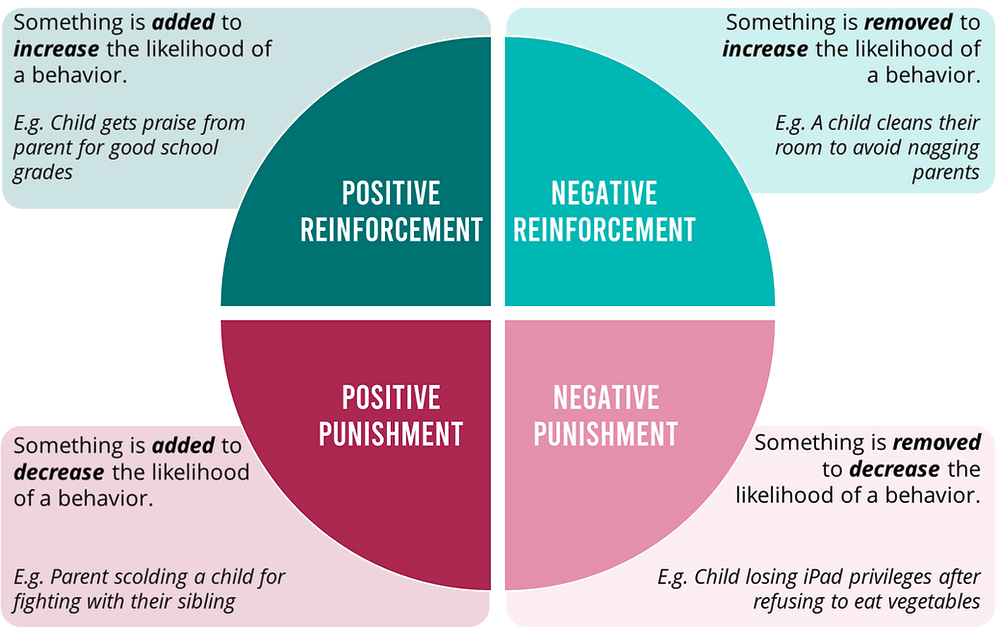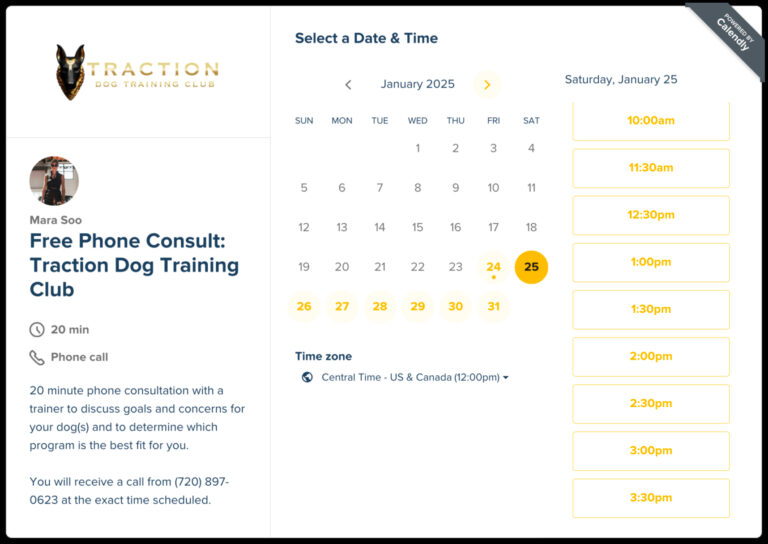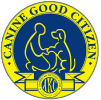dog training methods used
at traction
Traction Dog Training Club’s balanced dog training methods utilize all four quadrants of Operant Conditioning & Learning Theory.
Positive reinforcement is when your dog receives a reward that encourages a behavior we like.
For example, you give your dog a treat for laying down when asked.
Negative reinforcement is when your dog is rewarded by the release of pressure to encourage a behavior we like.
For example, the leash goes slack when your dog moves towards you instead of pulling.
Positive punishment is when something your dog dislikes happens to discourage them an unwanted behavior.
For example, you spray your dog with a spray bottle of water when they jump on the countertop.
Negative punishment is when something your dog likes is taken away to discourage an unwanted behavior.
For example, you stop petting your dog when they jump on you.

mother nature’s way
relating balanced dog training methods
to real life
positive reinforcement
- You earn a bonus for a positive performance review at work
- Amazon gives you $2 off your order for choosing a later delivery date instead of 2-day delivery
- Retail websites send you coupon codes for giving them your email address and opening their emails
- A child earns an allowance for doing their chores
- A tasty apple falls off of a tree when you shake it
- —> In the dog world: Dogs that insist on certain behavior from other dogs are rewarded by getting what they want. For example, a mother dog corrects (nips, growls, etc.) her puppies when they refuse to be groomed and is rewarded by the puppy accepting her grooming. There are few other examples of positive reinforcement amongst dogs.
Analysis: Positive reinforcement is great for getting people/dogs to take specific actions.Positive reinforcement actively engages a dog’s or human’s ability to think operantly, clearly understanding and manipulating cause and effect. The immediate and often tangible reward is easy to understand.
negative reinforcement
- You put your seatbelt on to get your car to stop beeping at you
- You rush to complete a task so your boss stops nagging you about it
- You eat a snack to relieve your hunger
- You loosen your belt to relieve the pressure from pants that are too tight
- You get out of bed to turn off your alarm
- In the dog world: One example within the dog world occurs when a dog uses aggression to get another dog to go away. For example, a dog growls when another dog approaches their food bowl and causes them to leave their food alone.
Analysis: Negative reinforcement is the main language of the natural world. Our wants, physical feelings, and emotions are all for the purpose of using negative reinforcement to get us to take care of ourselves. We eat to turn of hunger (or boredom, or stress). We make a fire or turn on heat so that we can stop feeling cold. For humans and dogs alike, negative reinforcement is the easiest to understand and most natural way to learn.
positive punishment
- You get a parking ticket for parking in the wrong spot
- A child has to go to summer school for getting bad grades
- You touch a hot stove and get burned
- You run on on a slippery surfaces and fall
- You get bitten when you try to pet an aggressive animal
- In the dog world: Dogs commonly “correct” each other for unwanted behavior, like snapping at another dog for humping them. They also experience positive punishment, such as getting stung by a bee when they try to catch it.
Analysis: Positive punishment is common within nature and amongst animals. Dogs bite, snakes strike, cats scratch, and a porcupine has quills all used to stop unwanted behavior from others within and among species. Punishment in the animal world does not always have to be dramatic, though. Dogs in the same household “correct” each other usually on a daily basis for things like asking to play too much, humping, going in a spot the other dog has claimed, etc. It is part of a natural, balanced relationship.
negative punishment
- A child goes to time out for pushing a classmate
- You lose your job for speaking inappropriately to your boss
- Your car stops working if you fail to put gas in it
- You lose your driving privileges if you do not renew your license and registration
- Your friend stops calling you after you decline their call
- In the dog world: Dogs naturally learn that they will lose their resources if they don’t keep watch over them and protect them. A dog buries their bone to avoid it getting stolen by another animal.
Analysis: Negative punishment is less obvious when it happens, but also common in nature. It is often less intentional and more natural as a consequence; if you do something horrible to a friend, you lose the friendship. If you don’t put your food in the fridge, it goes bad. For highly driven dogs, the loss of an opportunity to earn food or a toy can be devastating compared to experiencing positive punishment.
why don't we use
only positive reinforcement (+r) training methods?
Positive-reinforcement-only training is a philosophy that says you should only give a dog rewards for doing correct behaviors. If a dog does something that is incorrect, unwanted, inappropriate, or dangerous, you should ignore it or avoid causing the same behavior in the future.
Real life makes it impossible to pull this off. Your dog will experience positive punishment when they dart off after a squirrel and hit the end of the leash because you couldn’t run fast enough to follow them to the squirrel! They’ll experience negative punishment when they lose your attention and affection for jumping.
Many positive-only trainers use other training methods inherently without realizing or advertising it. For example, it is an extremely common practice to withhold food for periods before training sessions so that a dog is very hungry and therefore more motivated to work for treats. This is a classic form of negative reinforcement. The dog is intentionally made very uncomfortable by their hunger, then rewarded for correct behavior using food.
Even equipment advertised as positive-only actually relies on negative reinforcement to work. As an example, front-clip harnesses work because they put uncomfortable pressure on a dog’s shoulders and spin their body away from where they want to go. This is a direct use of pressure and release training.
Our trainers prefer to be honest about how animals (and humans) naturally and realistically learn. In our experience, choosing to acknowledge and strategize the way dogs naturally learn makes for the strongest bond, the fastest learning, and the safest training.
Because it becomes much harder for the dog to figure out what we want from them and how to earn rewards (treats, toys, praise, or otherwise). For anxious or aggressive dogs, it takes longer for them to learn that they are not in danger and can relax.
A common misconception is that negative reinforcement and positive punishment are stressful for dogs. To the contrary, we teach dog owners to correct their dogs with calmness and kindness. The use of multiple forms of communication (balanced dog training methods) is simply a way of helping your dog understand how to be successful.
Using positive reinforcement only (+R) inevitably restricts our ability to communicate with our dogs
Positive-only dog training methods allow us to give feedback on what we do want but does not allow any feedback on
what we don’t want or what is dangerous. This muddles communication and fails to stop many self-rewarding behaviors like stealing food off counters.
It’s important to set behaviors while dogs are new to the family and to set realistic expectations for your family. Furthermore, many of the dogs we train simply do not have months or years to stop acting aggressively or dangerously. If your dog acts aggressively towards dogs, people, bikes, or otherwise, you are at risk of expensive fines and court fees for small offenses all the way up to prison time and euthanasia if someone gets injured.
For example, if your dog has a strong prey drive and values chasing rabbits over getting treats or toys, it is extremely difficult to teach your dog to focus around rabbits using treats and toys only. On the other end of the spectrum, some dogs do not value treats or toys.
As police and protection dog trainers, we understand that high drive dogs must be properly motivated to act safely at all times. Simply asking your dog to listen to obedience commands for treats will often fail to control your dog.
what do balanced dog training methods look like?
The beauty of balanced training is that we can craft just the right approach for the individual dog at hand. Some dogs do best with almost purely positive reinforcement training. Others learn best and are most at ease with negative reinforcement training. Schedule a free consultation with our Head Trainer to discuss what may be best for your dog.
Watch this video of our Head Dog Trainer Mara Soo training a place command with a new dog:







